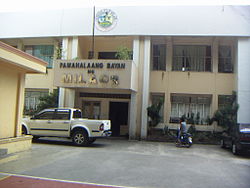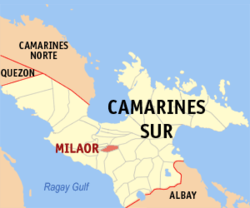Top Qs
Timeline
Chat
Perspective
Milaor
Municipality in Camarines Sur, Philippines From Wikipedia, the free encyclopedia
Remove ads
Milaor, officially the Municipality of Milaor (Central Bikol: Banwaan kan Milaor; Tagalog: Bayan ng Milaor), is a municipality in the province of Camarines Sur, Philippines. According to the 2020 census, it has a population of 33,963 people.[3]
Remove ads
Milaor is part of the Metro Naga Urban Area. It is 17 kilometres (11 mi) from Pili and 433 kilometres (269 mi) from Manila.
Remove ads
History
Summarize
Perspective
The work of evangelization in Milaor began in 1579 when the Franciscan missionaries came to the Philippines upon the order of Pope Sixtus V and King Philip II, and given specific assignment to work in Bicol Region. In 1585, Milaor was declared a parish under the titular patron, Saint Joseph. The first parish administrator was Fray Matias de Andrade, OFM., who arrived in Bikol in 1582 and later became the fifth Bishop of the Diocese of Nueva Caceres.
The Franciscans, Fray Juan del Sacramento and Fray Jose dela Virgen, initiated the construction of a church made of bricks and stones. This was built in a place known today as "Sinimbahanan" now a part of Cabusao, where ruins of the concrete foundation may still be found. Frequent attacks from the cimarrones and the tulisanes from nearby Mount Isarog, however, caused the transfer of the church to its present site. Fray Santiago de San Pedro de Alcantara completed the construction in 1730 and added a convent made of wooden materials in 1735. Both the church and the convent were destroyed by fire in 1740 and immediately the reconstruction was undertaken by Fray Francisco delos Santos, OFM. The present belfry was finished in 1840.
Milaor was formerly called "Milaud" or "may-laud". "Laud" means a lowland prone to being flooded, in fact that is being true up to this day. The expression "mapa-laud" means to go to a place which is low or with water, in other words, to go to a "laud". From "Milaud" or "Maylaud" it was transferred to "Milaor". The truth of this matter of the place being always filled with water is corroborated by the fact that in many barangays are to be found shells which thrive on water. These shell fossils mean that in ancient time this place was really covered with water or is frequently flooded to allow these shells or mollusks to thrive in the place.
Originally, Milaor comprised Palestina and the present parishes of Minalabac, San Fernando and Gainza. Until the eve following the uprising Naga City on September 19, 1898, during the Philippine Revolution, the Franciscan considered Milaor as their favorite resting place and abode away from the adjacent rapidly developing settlement that is Naga City today.
Remove ads
Geography
Summarize
Perspective
Barangays
Milaor is politically subdivided into 20 barangays. Each barangay consists of puroks and some have sitios.
Just like most cities in the Philippines, Milaor has a barangay system which is the core Local Government of the Philippines. Each barangay is headed by a chairman and barangay councils who were elected to office by popular vote of the community registered voters every three years.
- Alimbuyog
- Amparado (Pob)
- Balagbag
- Borongborongan
- Cabugao
- Capucnasan
- Dalipay
- Del Rosario (Pob)
- Flordeliz
- Lipot
- Mayaopayawan
- Maycatmon
- Maydaso
- San Antonio
- San Jose (Pob)
- San Miguel (Pob)
- San Roque (Pob)
- San Vicente (Pob)
- Santo Domingo (Pob)
- Tarusanan
Climate
Remove ads
Demographics
Summarize
Perspective
In the 2020 census, the population of Milaor, Camarines Sur, was 33,963 people,[3] with a density of 1,000 inhabitants per square kilometre or 2,600 inhabitants per square mile.
Languages
Central Bikol language is primarily being used in the town. Most people in Milaor speak the Coastal Bikol (Naga dialect) as their main language. While further south closer to Minalabac speaks a little of Rinconada Bikol which is recognized as a minority language. Tagalog is a secondary language in the town primarily used for tourists and visitors that cannot speak Bicolano language. Residents speak English as well when they go to work or school.
Religion
Parishes (Catholic Church in Milaor)

St. Joseph the Worker Parish
St. Joseph the Worker is the titular patron saint of the Municipality. The town and parish fiesta are celebrated every 1st day of May. The present parish priest is Rev. Fr. Ruben R. Buena. The vision of the parish is to continue forming Basic Ecclesial Communities, locally called as SKK or Saradit na Kristiyanong Komunidad. The locus and focus of this dream of the Church is by clustering all the neighboring families. Each cluster is composed of 15-20 families.
St. Anthony of Padua Parish
On May 13, 1994, another parish within the municipality of Milaor was established. The seat is at barangay San Antonio and the titular patron saint is St. Anthony of Padua. At present the parish priest is Rev. Fr. Edgar L. Barias, SOLT.
Economy
Summarize
Perspective
Poverty incidence of Milaor
10
20
30
40
50
2000
42.12 2003
36.03 2006
36.90 2009
36.63 2012
27.13 2015
32.81 2018
17.67 2021
27.55 Source: Philippine Statistics Authority[10][11][12][13][14][15][16][17] |
Formerly a sleepy suburb of Naga City Milaor became one of the most commercialized municipalities alongside Sipocot, Calabanga, Pili, Nabua and the nearby town of Canaman. This is due to its proximity to Naga City's CBD II and Almeda CBD. Its location along the National highway also makes it boom. Milaor hosts large Warehouse companies such as CitiHardware, Olivan Depot, Atlantic Bakery, Milaor Trading Corporation, Milaor Cement Corp and others. The municipality has a provincial cockpit arena and several financial institutions such as BDO Network Bank and M Lhuillier.
Most people in the municipality are farmers and fishermen. However, since Milaor is close to Naga City (3 kilometers south), within the Manila-Naga road, and is the site of the upcoming Camarines Sur expressway, it has become a location of a great number of warehouses. Also because of its proximity to Naga City, it has become a population spillover, with many housing subdivisions being located, as well as entertainment centers. Camarines Sur Sports Arena is located in Brgy. Tarusanan.
Typical agricultural produce includes:
- Corn
- Palay (rice)
- Coconut
- Wheat
- Mango
Remove ads
References
External links
Wikiwand - on
Seamless Wikipedia browsing. On steroids.
Remove ads






